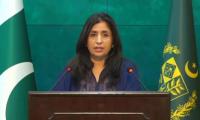LAHORE: While peaks in American aid to Pakistan have followed years of neglect, the financial assistance from Washington DC to Islamabad has often witnessed suspension or cuts at crucial moments too!
Research conducted by the “Jang Group and Geo Television Network” shows that there have been more than half a dozen instances during the last 65 years since 1954, when the US military aid to Pakistan was suspended by Washington under one pretext or the other.
It goes without saying that whenever the American aid was parked in Pakistan’s coffers, strings were attached.
Though the United States was one of the first countries to recognize Pakistan as an independent state in 1947, it took Washington DC some seven years to dish out its first military assistance to Islamabad during President Dwight Eisenhower’s regime. On May 19, 1954, the ‘Mutual Defence Assistance Agreement’ between the two nations was inked at Karachi.
This pact was helped vastly by the refusal of Pakistan’s first Prime Minister Liaquat Ali Khan to visit Moscow in 1950. Liaquat Ali Khan had toured the United States, instead of the former Soviet Union, to the sheer delight of the Americans.
Liaquat Ali Khan’s decision had resulted in the arrival of nearly $700 million military aid to Pakistan between 1954 and 1964. This military aid was dished out in addition to the $2.5 billion given to Pakistan as economic aid. Here follows the chronology of major US military aid suspensions since 1954:
1) The first time when the US suspended its military aid to Pakistan was during the 1965 Pak-India War. Even though the United States suspended military assistance to both the neighbours, who were at daggers drawn with each other, the suspension of aid affected Pakistan much more adversely. Gradually, relations improved and arms sales to Pakistan were renewed in 1975. It is noteworthy that between 1954 and 1965, Pakistan had managed to receive $50 million in military grants, $19 million in defence support assistance and $5 million in cash or commercial purchases from Washington DC.
2) During the 1971 Pakistan-India War, the US again suspended its military aid to Pakistan, the second time in just six years. In 1972, US President Richard Nixon visited China for the first time, marking the beginning of a process of normalization of the estranged Sino-American relations. Since the historic visit was facilitated by Pakistan, the United States resumed limited financial aid to Pakistan as a ‘reward.’
3) In April 1979, the United States cut off its military assistance to Pakistan, except food assistance, as required under the “Symington Amendment.” This time the suspension had resulted due to Washington DC’s concerns about Pakistan’s nuclear programme. It is pertinent to note that during this period, Pakistan had managed to construct a Uranium enrichment facility.
In December 1979, the Soviet Union invaded Afghanistan. The US offered $400 million worth of military aid, which was rejected by Pakistan as being ‘inadequate.’
In 1981, the US again offered a package of military aid worth $1.5 billion, which was accepted. During the five years that followed after the influx of this aid, the US provided 40 F-16 fighters, 100 M-48 tanks, 64 M-109 155 mm SP howitzers, 40 M-110 203mm SP howitzers, 75 towed howitzers and 1,005 TOW anti-tank missile system, all of which enhanced Pakistan’s defence capability substantially.
The aid rose from around $60 million in economic and development assistance in 1979 to more than $600 million a year in the mid-1980s. In total, the United States gave $2.19 billion in military assistance from 1980 till 1990. The military aid was in addition to the $3.1 billion economic assistance for Pakistan.
4) As soon as the Soviets withdrew from Afghanistan in 1990, US military aid was again suspended under the provisions of the “Pressler Amendment.” The US imposed curbs on all economic and military aid to Pakistan. The “Larry Pressler-proposed Amendment” required the then US President to certify to the Congress that Pakistan did not possess nuclear weapons. However, in 1995, the “Brown Amendment” had authorized a one-time delivery of US military equipment worth $368 million. However, no fewer than 28 F-16 aircraft costing $658 million were not delivered to Pakistan, despite the fact that Islamabad had paid for them well in advance.
5) The Pak-US relations witnessed a severe blow with Pakistan’s nuclear tests and the ensuing sanctions in 1998. A Presidential visit scheduled for the first quarter of 1998 was postponed and, under the “Glenn Amendment,” sanctions restricted the provision of credits, military sales, economic assistance and loans to Pakistan.
6) The ouster of Premier Nawaz Sharif in 1999 in a military coup led by General Pervez Musharraf gave the US government another reason to invoke fresh sanctions under Section 508 of the “Foreign Appropriations Act,” which included restrictions on foreign military financing and economic assistance. The assistance was thus restricted to refugee and counter-narcotics assistance only. Aid to Pakistan dropped dramatically from 1991 to 2000 to a paltry $429 million in economic funding and $5.2 million in military assistance.
7) In November 2018, US President Donald Trump had reiterated that the $1.3 billion in aid to Pakistan would remain suspended till the country acted against militant safe heavens inside its territory.
"I want Pakistan to help us. We're no longer paying $1.3 billion to Pakistan. We're paying them nothing because that's what they've done to help us. Nothing," President Trump had told reporters at the White House.
Earlier, in September 2018, the Trump administration had cancelled about $300 million in military aid to Islamabad for not doing enough against terror groups like the Haqqani Network and the Taliban active on its soil.
While there is no doubt that an overwhelming majority of resident Pakistanis and the Pakistani-Americans had started supporting the likely US President Hillary Clinton and bashing Donald Trump vehemently after the latter had called for a ban on Muslims from entering the United States, a good number of Indian people and a large section of their media had developed a strong liking for Trump.
During the last leg of his election campaign, Trump had described Indian Premier Narendra Modi as a "great man" and had publicly admitted he was a "great fan of the Hindus."
LHC Justice Muhammad Iqbal announces reserved verdict rejecting PTI founder’s plea
Committee raises serious concerns over absence of Chairman Wapda in meeting
Committee decides to summon planning minister to address funding gaps and remove obstacles hindering progress
Official says due to widespread presence of polio virus in Balochistan, further preparations are essential to ensure...
Court instructs petitioner to remove objections of registrar’s office within seven days
Deputy PM highlights CICA’s immense potential in addressing region’s key challenges including political disputes







